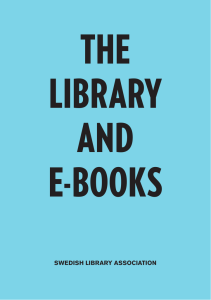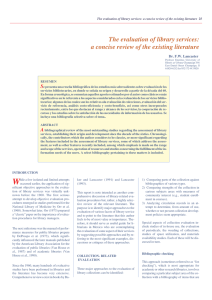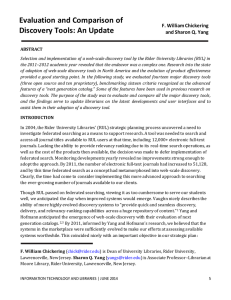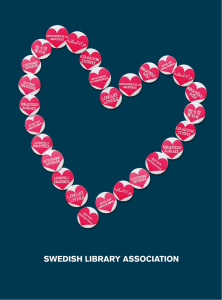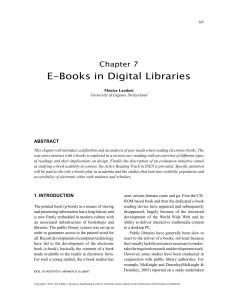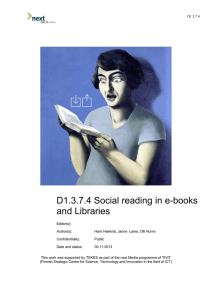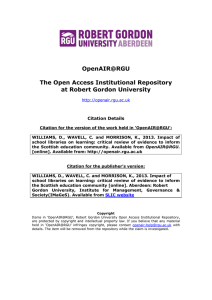New Trends in Digital University Libraries
Anuncio
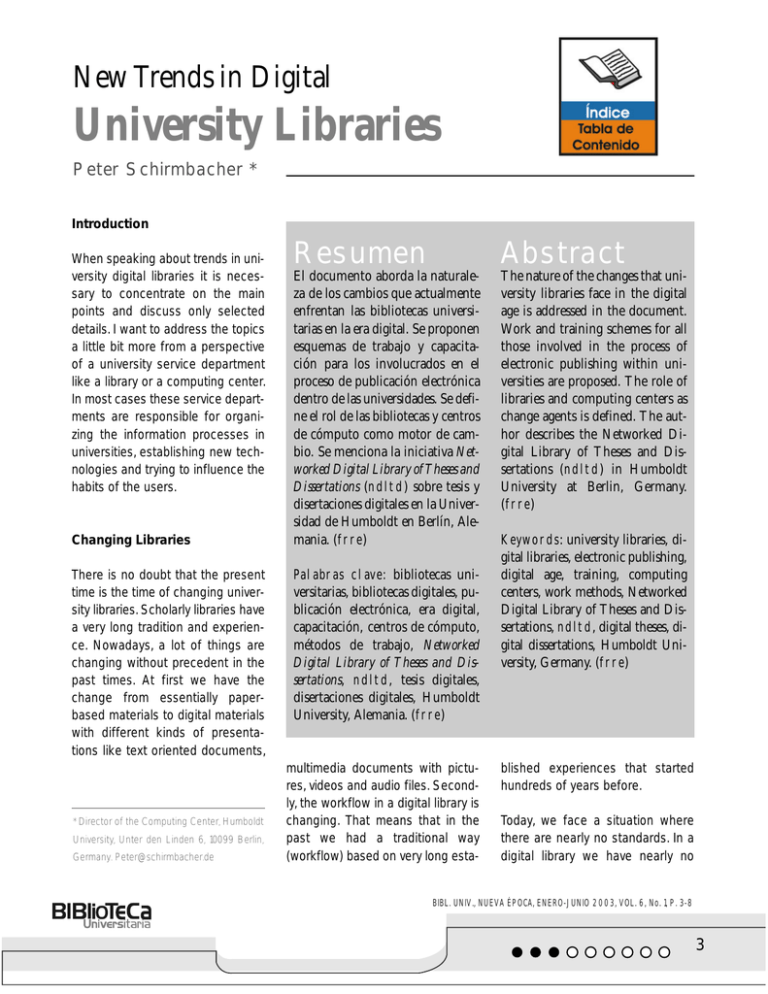
New Trends in Digital University Libraries Peter Schirmbacher * Introduction When speaking about trends in university digital libraries it is necessary to concentrate on the main points and discuss only selected details. I want to address the topics a little bit more from a perspective of a university service department like a library or a computing center. In most cases these service departments are responsible for organizing the information processes in universities, establishing new technologies and trying to influence the habits of the users. Changing Libraries There is no doubt that the present time is the time of changing university libraries. Scholarly libraries have a very long tradition and experience. Nowadays, a lot of things are changing without precedent in the past times. At first we have the change from essentially paperbased materials to digital materials with different kinds of presentations like text oriented documents, * Director of the Computing Center, Humboldt University, Unter den Linden 6, 10099 Berlin, Germany. [email protected] Resumen Abstract El documento aborda la naturaleza de los cambios que actualmente enfrentan las bibliotecas universitarias en la era digital. Se proponen esquemas de trabajo y capacitación para los involucrados en el proceso de publicación electrónica dentro de las universidades. Se define el rol de las bibliotecas y centros de cómputo como motor de cambio. Se menciona la iniciativa Networked Digital Library of Theses and Dissertations (ndltd) sobre tesis y disertaciones digitales en la Universidad de Humboldt en Berlín, Alemania. (frre) The nature of the changes that university libraries face in the digital age is addressed in the document. Work and training schemes for all those involved in the process of electronic publishing within universities are proposed. The role of libraries and computing centers as change agents is defined. The author describes the Networked Digital Library of Theses and Dissertations (ndltd) in Humboldt University at Berlin, Germany. (frre) Palabras clave: bibliotecas universitarias, bibliotecas digitales, publicación electrónica, era digital, capacitación, centros de cómputo, métodos de trabajo, Networked Digital Library of Theses and Dissertations, ndltd, tesis digitales, disertaciones digitales, Humboldt University, Alemania. (frre) multimedia documents with pictures, videos and audio files. Secondly, the workflow in a digital library is changing. That means that in the past we had a traditional way (workflow) based on very long esta- Keywords: university libraries, digital libraries, electronic publishing, digital age, training, computing centers, work methods, Networked Digital Library of Theses and Dissertations, ndltd, digital theses, digital dissertations, Humboldt University, Germany. (frre) blished experiences that started hundreds of years before. Today, we face a situation where there are nearly no standards. In a digital library we have nearly no BIBL. UNIV., NUEVA ÉPOCA, ENERO-JUNIO 2003, VOL. 6, No. 1, P. 3-8 3 New Trends in Digital University Libraries established, ever changing technologies. The whole life cycle within a library, starting with acquisition, exploitation, cataloguing, long-term preservation and retrieval, has nearly completely changed. We discussed metadata and created the Dublin Core Metadata Set. But I do not know the percentage of libraries, which are already using the Dublin Core for all their stored materials. There is no consistency in describing multimedia documents. In most cases there is no procedure to secure the authenticity and the integrity of the digital document. We are at the very beginning of the construction of “the library without walls”, trying to define the course and extent of this change. Electronic publishing is still at the beginning of its development. This is why it is so important to develop and use standards and principles widely. With the advent of W3C specifications of XML, the ISO standardization of the Dublin Core Metadata Set, the Open Archives Initiative, and others, global efforts towards standardization are now a reality. However, a new “culture of electronic publishing” is necessary. The Process of Electronic Publishing Use and provision of scientific documents in digital format via the Internet are an improved form of scholarly communication, as compared to the conventional publication in printed form. It is necessary, however, that all the parties involved adapt their working methods to these new opportunities. This starts right with the author who can support high-quality retrieval by specifically structuring the text. However, a vast reform of work routines and responsibilities will be demanded from service departments like libraries or computing centers. BIBL. UNIV., NUEVA ÉPOCA, ENERO-JUNIO 2003, VOL. 6, No. 1 4 Universities and their scientists who are not only producers, but also main players and consumers of information, can take an active and shaping role in distribution through a comprehensive university network of document and publication servers, by employing a well mappedout policy. Texts and documents that are produced at universities like dissertations, professional qualifications, research reports, pre- Peter Schirmbacher prints, lecture notes, and other materials known as gray literature, are rarely published by publishing houses or distributed by booksellers. These materials can now be produced at much lower costs. They can also be distributed a far better, and they can be more easily indexed and designed to reach and meet user’s needs. Within the university, legal, financial, personnel, and material foundations for supporting the publication process of electronic documents have to be established: University Repositories Legal foundations, like the agreements to safeguard authors’ rights as well as the recognition of electronic-only documents such as professional qualifications. Financial and material foundations on one side are mainly influenced by Costs for computer hardware and software, Personnel costs for systems maintenance, and on the other hand by Savings by rationalization in comparison to previous publication methods, and Revenues from sales to third parties. Expenditures for personnel are defined according to the technologies used. These expenses depend on the intensity of taking care of potential authors, the degree of processing the publica- The network of documents and publication servers forms the technological core of the publication process. The university should work out a policy that defines the basis of the technological and long-term approach on how to treat these documents. Following the acquisition policy of the respective university it should be decided which kind of documents will be included into the server, and the criteria of treatment, e.g. for long-term preservation. Such policy should include commitments to the following fields: Securing server access Guaranteeing authenticity and integrity of documents Define the criteria for long-term preservation Define the accepted document formats and their conversion tools, oriented towards long-term established standards like SGML and XML tion for long-term archiving and preservation, and the integration of the electronic publication process into the technological course within the library and the computing center. Define the metadata set (oriented towards Dublin Core) and its entry Decide on a search engine, and thus defining retrieval options 1 Digital Preservation and Archiving Jay Jordan1 writes about the importance of digital preservation and archiving. He describes some examples and developments in the United States, United Kingdom and Australia. All these attempts are very important and bring us a little bit closer to the solution of unsolved problems. In a paper of the German Initiative of Networked Information (called DINI ) comparable with the American Coalition of Networked Information, we wrote: “The majority of these projects dealing with long-term availability of digital publications use the reference model Open Archival Information System (OAIS ).2 This model stems from the context of the data archives of space travel, Meteorology, and Astrophysics. It claims to completely describe the functioning scale of an archiving system for any data at all. This model include: Jordan, Jay. Trends in Digital University Libraries. Biblioteca Universitaria, Nueva Época, vol. 5, no. 2, julio-diciembre, 2002, p. 122-123. 2 http://ssdoo.gsfc.nasa.gov/nost/isoas/ref_model.html BIBL. UNIV., NUEVA ÉPOCA, ENERO-JUNIO 2003, VOL. 6, No. 1 5 New Trends in Digital University Libraries The transfer and the inclusion of data into the archive Their secure placement in storage systems The management of metadata relevant for long-term archiving Applying methods for long-term archiving Securing the permanent usability of the archived data Establishing the interoperability of OAIS-compliant archives Information Habits Jay Jordan describes the habits of study3 of the typical users of a modern library. We can observe the same development in Germany. It is important, that we find the right conclusions and measures to drive this evolution. We have to organize education to meet the information needs and skills of the different groups of participants in the process of electronic publishing and consumption of electronic information in the scenario of digital libraries. For Authors A recommendable, long-term publication model that is based on the use of XML / SGML as the archiving format. Although, XML is the format 3 Jordan, Jay. Trends in Digital University Lib- raries. Biblioteca Universitaria, Nueva Época, vol. 5, no. 2, julio-diciembre, 2002, p. 127. that is often used for designing web presentation of documents, tools for authors of scholarly works, rarely exist. The conventional text editors so far may include components that allow a later, almost automatic conversion of documents into XML . While preparing the submission of the document, authors therefore have to be specifically trained on using these tools for structural mark-up. To promote a greater contribution of scholarly documents in electronic format within a university, the establishing of the following services is recommended: Contact with authors. The library should offer a contact for the electronic publishing of documents. Web-based information system. The software developed for electronic publishing should be installed on a university server. The university’s homepage would provide advice and information for interested authors. General information lectures. In short regular information lectures authors and contact persons in the departments would familiarize with the procedure of electronic publishing. These events can also serve as a multiplier training, especially when staff from the departments is addressed specifically. Authors’ training. Carrying out regular training or introductory BIBL. UNIV., NUEVA ÉPOCA, ENERO-JUNIO 2003, VOL. 6, No. 1 6 classes to work with style sheets for text processing systems is considered to be essential. This will guarantee a high quality standard of the received documents. For authors, it is important that the earlier they take part in these training courses, the easier it will be later for them to prepare their documents for electronic publishing. As long as there are no adequate tools that allow direct writing and setting up an archiving format like SGML / XML, the use of common text processors aiming to a conversion into an archiving format requires specific training. For the Service Staff To teach the use of digital documents, the control, and the conversion into representation and archiving formats, requires regular training of staff. These training courses have to be adapted to the specific tasks of the particular staff, including: Cataloguing of electronic documents, Dublin Core and metadata applications, Controlling the legibility of documents (using Word, WordPerfect, LaTeX), and enabling staff to advise and train the authors. Conversion into PDF Conversion into SGML Handling digital signatures and time stamps Peter Schirmbacher For readers Tackling the provided search engines is rarely systematic. Intelligent search engines, however, can process extensive additional information containing description of the structure and the contents of documents. This works as long as these descriptions are expressed in a machine-readable form following international standards (Dublin Core). To put these successfully into use within a search strategy requires users to know about these options. They should be aware of the structural characteristics that can be used in a conditioned search. Using this option specifically requires a wide dissemination of information and training for all scholars and students about the metadata that can be handled by search engines, and about intelligent search strategies to be employed within a search. The Humboldt University Project of Digital Theses & Dissertations The project Digitale Dissertationen was launched in September 1998 by the computing centre and the university library of the Humboldt University of Berlin. The main aim is to build up a digital library (a certified document server) for our university where official university publications such as theses and dissertations are archived and published on the Internet. Our efforts are espacially devoted to help authors to create their own digital publications, developing a workflow model for submitting electronic theses and handle them within the university library. Another effort is directed to modeling and testing a security solution for archiving digital publications. The project is available at http://dochost.rz.hu-berlin.de/epdiss/ index_en.html About NDLTD The NDLTD initiative, born in the USA, as an open federation of currently 145 member universities and supporting organizations, such as research institutions or private companies. NDLTD ’s activities are focused on universities, libraries, faculties and graduate students in order to support authoring, indexing, archiving, dissemination and retrieval of electronic theses and dissertations worldwide. NDLTD is aimed towards the improvement of graduate education by allowing students to produce electronic documents, use digital libraries, and understand issues in electronic publishing. NDLTD’s CHM Staff should not only carry out their tasks but should also be able to give qualified advice to authors. This requires a higher intensity in teaching and training than the one that is available at the moment. Humboldt University participates in the Networked Digital Library of Theses and Dissertations (NDLTD ) iniciative, applying international standards such as Dublin Core Data Set, XML and SGML. Currently there are 145 international members of the iniciative. vision is to increase the availability of student research documents for scholars and to preserve them electronically and to empower students to convey a richer message through the use of multimedia and hypermedia technologies. NDLTD encourages and supports universities to unlock their information resources and to advance digital library technology by sharing experiences, tools, technology and knowledge. BIBL. UNIV., NUEVA ÉPOCA, ENERO-JUNIO 2003, VOL. 6, No. 1 7 New Trends in Digital University Libraries I believe that cooperation and compliance to international standards will certainly pave the way. Goals The main goals of the NDLTD initiative are: for graduate students to learn about electronic publishing and digital libraries, applying that knowledge as they engage in their research and build and submit their own ETD, for universities to learn about digital libraries, as they collect, catalog, archive, and make ETDs accessible to scholars worldwide, for universities to learn how to unlock the potential of their intellectual property and productions, for graduate education, to improve through more effective sharing, and for technology and knowledge sharing to speed up, as graduate research results become more readily and more completely available. For more information about the iniciative access the following sites: http://www.ndltd.org/ http://tennessee.cc.vt.edu/~lming/ cgi-bin/ODL/nm-ui/members/ index.htm Conclusion The NDLTD initiative is only an example of cooperation and use of international standards devoted to unlock universities’ information re- sources and to advance digital library technology by sharing of experiences, tools, technology and knowledge. There is a lot of work to be done to define the course of the change towards the library without walls. References Biblioteca Universitaria: Revista de la Dirección General de Bibliotecas de la UNAM [online]. <http://dgb.unam.mx/revista.html> [March 2003]. Semestral. ISSN 0187-750X. JORDAN, Jay. Trends in Digital University Libraries. Biblioteca Universitaria, Nueva Época, julio-diciembre, 2002, vol. 5, no. 2, p. 115-129. Networked Digital Library of Theses and Dissertations (Official Members) [online].<http://tennessee.cc.vt.edu/~lming/cgi-bin/ODL/nm-ui/members/ index.htm> [March, 2003] Networked Digital Library of Theses and Dissertations [online]. <http:// www.ndltd.org/> [March, 2003] Open Archival Information System (OAIS ) [online]. <http://ssdoo.gsfc.nasa. gov/nost/isoas/ref_model.html> [March, 2003] Project “Digitale Dissertationen” at the Humboldt University of Berlin. [online]. Humboldt University. <http://dochost.rz.hu-berlin.de/epdiss/index_en.html> [March, 2003] BIBL. UNIV., NUEVA ÉPOCA, ENERO-JUNIO 2003, VOL. 6, No. 1 8 At present in Germany there are some different projects in the field of digital libraries. It is a main issue supported by the German Research Foundation (DFG). Of course, it is still necessary to discuss all the different issues related to this field like the foundation of electronic university publishing houses or printing on demand services and so on. Considering that the new trends in digital libraries have to be seen within a broader perspective, I would like to repeat my statement from the beginning of this document: “We are at the very beginning in setting up digital university libraries”. !
